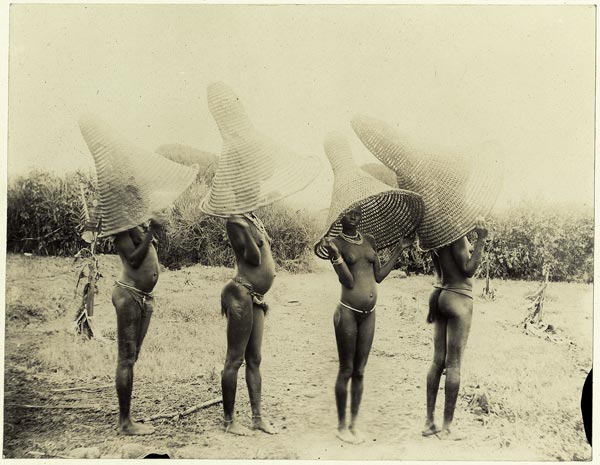Pitt Rivers Museum Luo Visual History

1998.209.44.3 (Print black & white)
Key Information
Photographer
Charles William Hobley
Description
These are Luo women going fishing with fishing basket traps (osech kiteng'a - osera means 'woven fishing trap' and kiteng'a is the fishing method of covering the fish in the water with this trap, with its pointed end upwards). Kiteng'a was always a fishing method for women only. The traps are made of those ropes seen being made in 1998.209.44.1 - .2 and they are usually carried on the head like this. These women are standing probably at the entrance of their homestead, which is apparently planted with some young banana trees. Their personal body adornments include wrist bracelets (minyonge), glass neck beads (tikng'ut) and glass waist beads (tik nungo). Three of the ladies wear skin or cloth aprons (olemo) on the front while the one to the extreme right wears a fibre tail (chieno) to her rear, suggesting that they are young married women. Unmarried ladies were traditionally not keen on kiteng'a fishing, which was done mostly by married women. [Gilbert Oteyo 06/05/05]
Cultural Group
Luo
Region
Nyanza Kisumu
Pitt Rivers Source
Charles William Hobley
Primary Documentation
Notes on PRM card - 'Women returning from fishing, Kisumu. Note: Fish traps carried on head.'
Publication History
Contemporary Publication - Reproduced as Plate XXXb (page 358) in C. W. Hobley's article 'British East Africa: Anthropological Studies in Kavirondo and Nandi' Journal of the Anthropological Institute of Great Britain and Ireland , Vol. 33 (Jul-Dec), 1903, with the caption 'Fisherwomen, Kisumu' [CM 24/04/2007]
Research Notes
It seems apparent that these women have been asked to pose by Hobley so as to show front, side and rear views, a common anthropological technique of the period. [CM 27/04/2007]
Date of Photograph
1902
Accession number
1998.209.44.3
Further Information
Photographic Process
Print gelatin silver
Date Acquired
Donated
Activity
Fishing
For citation use:
Pitt Rivers Museum Luo Visual History
"1998.209.44.3"
6 Jun. 2008. Pitt Rivers Museum.
Accessed 19 Nov. 2015
<http://photos.prm.ox.ac.uk/luo/photo/1998.209.44.3/>.
© Pitt Rivers Museum